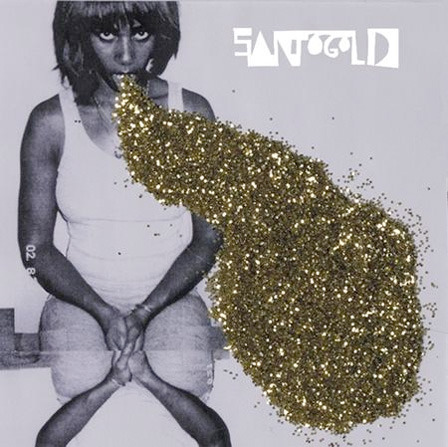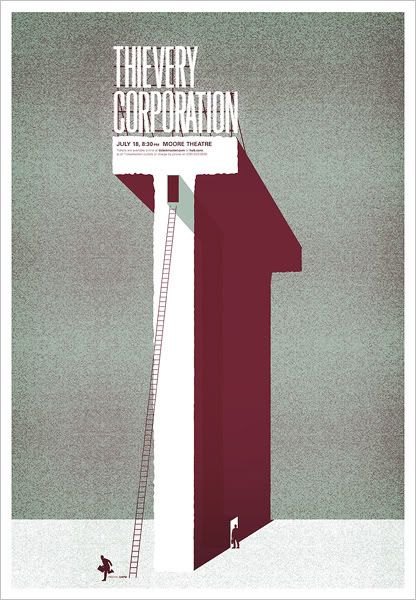
Great cover for Santogold by Isabelle Lumpkin. I can’t find any info about Isabelle online – if anyone knows who she is please let me know in the comments as I'd be interested in checking out some more of her work.
Monday 29 September 2008
Throwing up glitter
Posted by Phil at 12:36 1 comments
Labels: graphics, music, sleeve-art
Tuesday 23 September 2008
Andrio Abero

Great poster for Thievery Corporation by Andrio Abero.
Posted by Phil at 10:30 0 comments
Wednesday 17 September 2008
Sit on your favourite tune

Matther Plummer–Fernandez’s Sound/Chair began life as a sound, before being plotted on a three dimensional graph. The resulting shape was then crafted into a chair made from water–jet cut polyethylene. The result is a truly unique piece of furniture which any music lover must surely covet.
It’s on sale for the bargain price of £3950 at Designersblock’s temporary shop in Selfridges London for the duration of the London Design Festival.
You’ll need to get to the shop quickly, however, as I’m heading down there in my cat burglar outfit (complete with suction cups and grappling hooks) tonight to steal it.
Via DJ Chroma’s Tumblr.
Posted by Phil at 10:46 0 comments
Thursday 11 September 2008
More cowbell!
It's been a little while since a music related online service has come along which has made me drop everything and rush to try it out and find out more. MoreCowbell.dj is that thing. The service is a spin off of US tv show Saturday Night Live, where a special show featured Will Ferrell as Gene Frenkle, the cowbell player, and Christopher Walken as the music producer, Bruce Dickenson. It's simple but sure-to-be-massive mechanic allows users to add a variable amount of cowbell (and optional Walken) to any track they upload. They can then embed the newly modified track as a widget in their blog, social network profile etc. Here's one I made earlier:
The really exciting thing about MoreCowbell.dj is not the service itself, but the set of APIs that it's been built on. The Echonest provide a range of APIs which enable developers to build their own digital music applications without the need for expensive servers loaded with clever custom music software. Developers can use the service to analyse tracks and return important information like beats per minute and time signature which will undoubtedly lead to a whole raft of new browser based music apps.
Posted by Phil at 10:50 1 comments
Labels: digital, music, social-media, software, technology, widgets
Monday 8 September 2008
The laptop is a real instrument – official
DJ Chroma posted this article by Sasha Frere-Jones in The New Yorker about live bands using laptops on stage, which made me think.
When I’m not colouring in or sticking bits of the internet together with gaffer tape, I also like DJing. I remember the day I finally got my own Technics 1200s and a bad-ass Ecler scratch mixer. I practised very hard at first, then gradually a bit less hard. Then one day I realised that I had no new records because I had become so busy doing grown–up daytime stuff that I had no time to go to tiny crowded record shops and stand in line to use one of three available turntables to skip through the noisy bits of a bunch of 12s I often knew nothing about.
So I started using a laptop. I gave up scratching, juggling and the like (which I was only OK at after years of practice) and concentrated on playing music that people actually liked to dance to. I found that most of the labels I like sell downloads directly from their sites, and this meant that the night before I had to go out and play I could spend a couple of hours panic buying tunes from the comfort of my sofa.
Now I’m DJing more than ever (which was never very much to be fair) and people are actually dancing. My mixes aren’t always perfect, but no-one seems to care except me. And it’s all thanks to the laptop. My 1200s still look cool in my flat and occasionally I fire them up, but mostly they’re just really expensive conversation pieces. Come to think of it that 12" laptop is still pretty bulky. Can I justify spending £400 on a Tonium Pacemaker?
Posted by Phil at 21:06 0 comments
The Phonogra–
phantasmascope (or how to animate with a Technics turnable)
I’ve been staring at my 1200s for years and never thought of doing this. Bah! Found at the always excellent Monster Munch
Posted by Phil at 19:56 1 comments
Labels: animation, fun, music, technology, video
Tuesday 2 September 2008
It’s the end
of The End
I just found out from my friend Richard Hewitt than London’s legendary venue The End is due to close it’s doors in January after 13 years of top-notch dance floor action.
I've got a personal attachment to the club as I've spent many late nights over the last five years making interactive flyers for my long standing client Sancho Panza’s regular night at the venue’s AKA bar. I’ve also spent many late nights / early mornings in the club itself.
Looking back over the flyers in a misty-eyed sort of way, my favourites are:
The big long street that took a whole year to make
The one with the lighter
The one with the stop motion electronic man
The one which loads random 70s photos from Flickr that I made while on my holidays in Bermuda
The one where the users helped to brighten up London
The one where you could play along with the music on a drum
I'll miss The End & AKA dearly but it’s not the last of my work for Sancho Panza. We’re currently working hard on a brand new website which will be launching later this year.
Posted by Phil at 17:33 0 comments
Labels: clubbing, design, digital, flash, flyer, interactive
Should we be treating digital music like radio, not records?
For the first half of the twentieth century, commercial radio in the US was essentially illegal, and stations were subjected to the same kind of copyright lawsuits that P2P users are experiencing today. It was only after songwriters banded together to form The American Society of Composers, Authors and Publishers (ASCAP) that radio stations went legit. In return for a fee the radio stations gained the right to play whatever music they liked.
The Electronic Frontier Foundation has an idea called Voluntary Collective Licensing which would apply a similar logic to digital music. The idea is that the music industry forms several “collecting societies” which offer file-sharing music fans the opportunity to “get legit” in exchange for a reasonable regular payment (something like $5 - $10 a month). The money collected would be divided among rights-holders based on the popularity of their music.
I think this is a good idea. It differs from a subscription model in that it allows users to choose the service that they want to use, and it also allows for user generated music libraries such as the ill-fated Oink to operate legally. The license fee could easily be rolled into consumer products such as broadband internet or mobile data packages (unlimited digital music sharing for an extra £5 a month!), and P2P users already do a much better job of publishing, cataloguing and documenting music than the music industry themselves.
You can read the full article over at Electronic Frontier Foundation where they have neatly set out their case and attempted to provide answers to many of the inevitable questions that arise.
Posted by Phil at 17:02 0 comments
Labels: digital, licensing, music, opinion, technology
